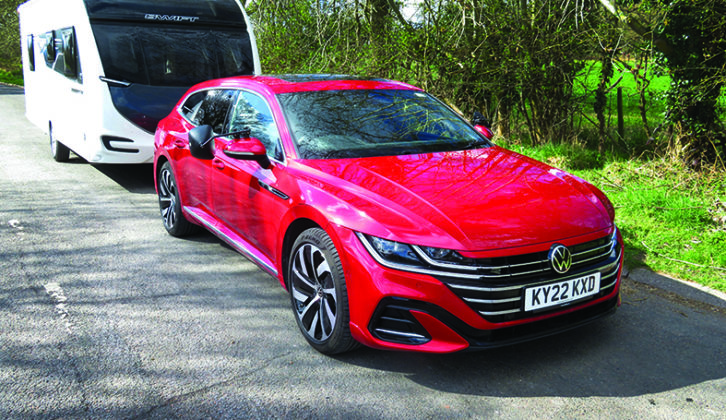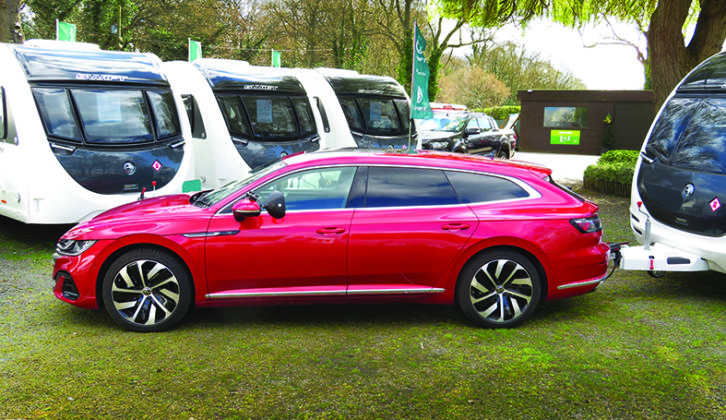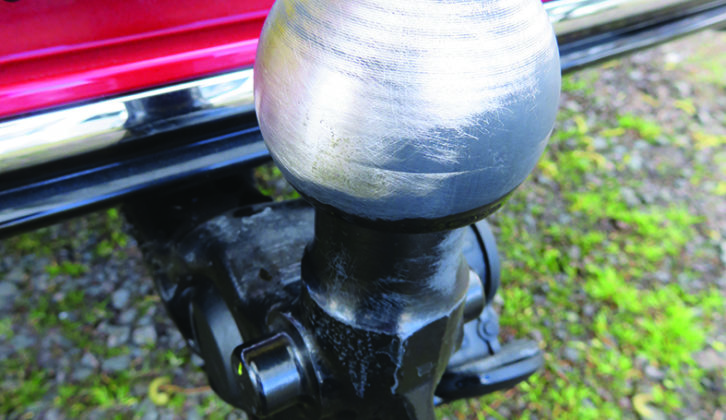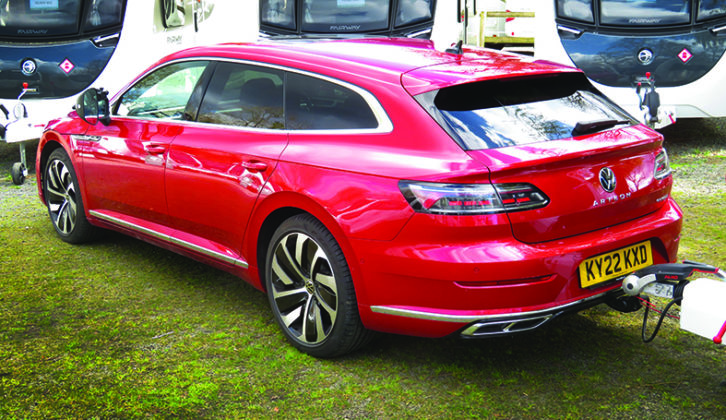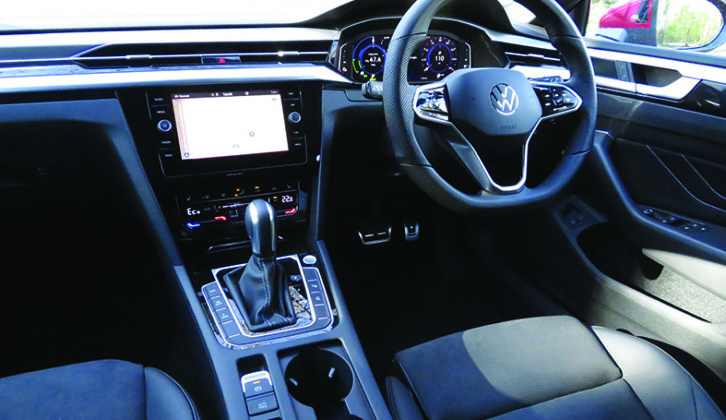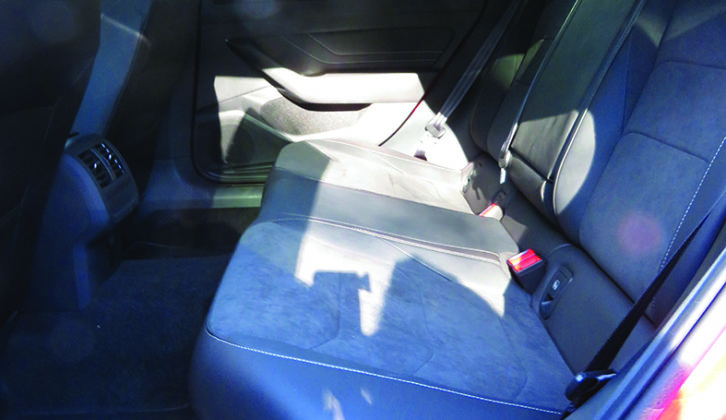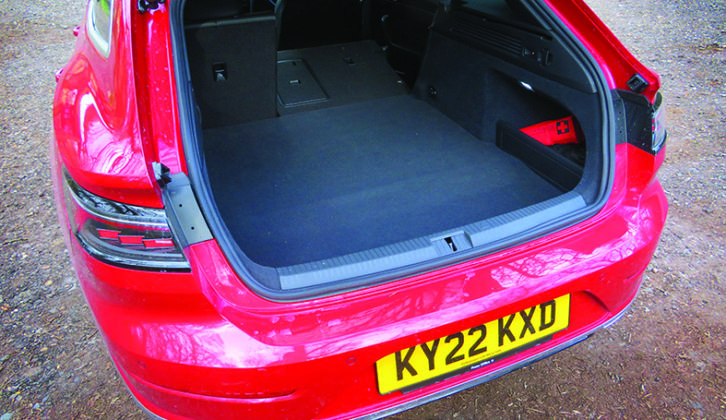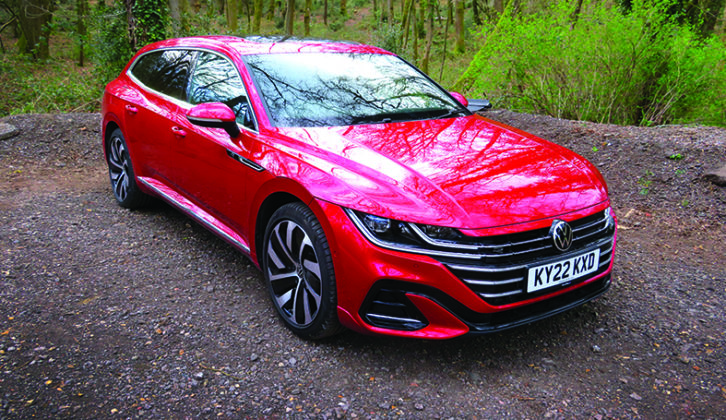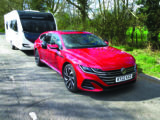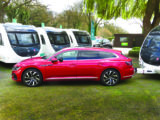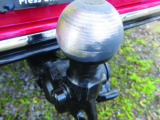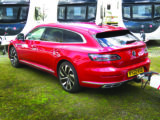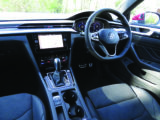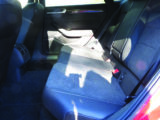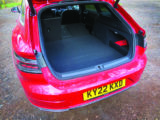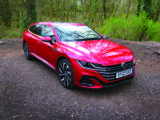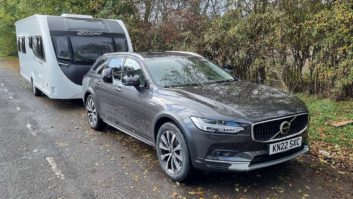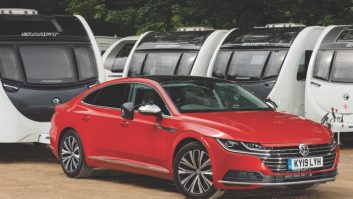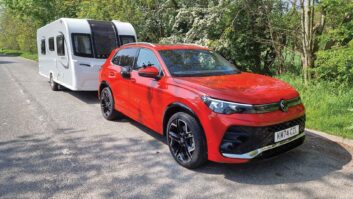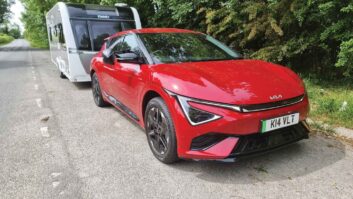We’ve driven a four-door coupé version of the Arteon – our Tow Car of the Year in 2019 – before and were impressed with its towing ability. Now Volkswagen offers the car in a second body style: the Shooting Brake. If the term is unfamiliar, it’s an old name for an upmarket estate.
Whether or not you plan to join a shooting party come the Glorious 12th, there are good reasons to choose the Shooting Brake over the regular Arteon.
The most obvious is boot space, which increases from 563 to 590 litres for regular petrol or diesel models. However, if you choose the plug-in hybrid, luggage space is compromised to house the electrical components, dropping to 455 litres.
What are we looking for?
Does choosing the petrol-electric version (we’re testing the Arteon Shooting Brake Hybrid 1.4 TSI 218PS R-Line specifically here) spoil the Arteon’s practicality? And is the car economical while towing?
Towing ability
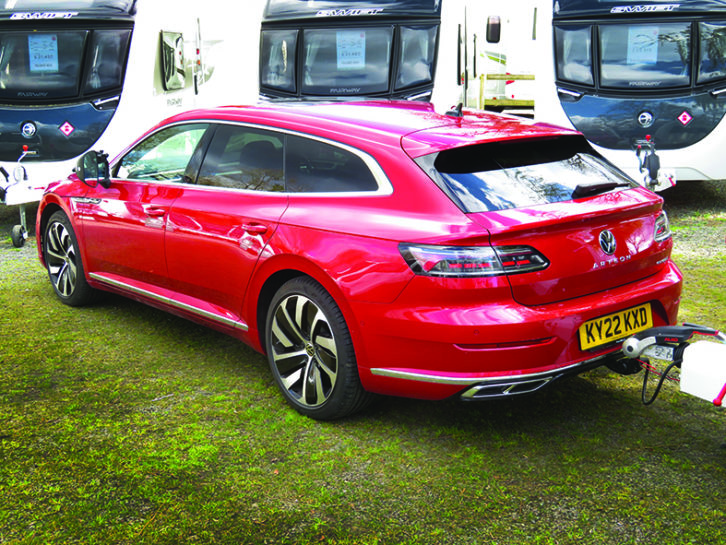
We’ve had mixed experiences towing with plug-in hybrids, but over the past couple of years, this class of tow car really seems to have come of age.
The Arteon Shooting Brake is a good example. It scares its powertrain with the excellent Volkswagen Passat GTE, a car we’ve towed with and found very capable.
With a combined electric and petrol power output of 218hp, and maximum pulling power of 295lb ft the Arteon Shooting Brake looks to have the necessary muscle for towing a well-matched caravan.
With a kerb weight of 1814kg, the Arteon has an 85% match figure of 1542kg. That’s within the car’s 1600kg towing limit, but not by much. However, a 1600kg maximum is reasonably healthy for a plug-in hybrid.
We matched the Shooting Brake to a Swift Conqueror 560, borrowed from Broad Lane Leisure. With a MiRO of 1558kg , the Swift was almost exactly an 85% match.
Our tow test started with the battery almost full, having used a setting that employs the petrol engine as a generator on the way to collect the caravan. The car defaults to electric running if the battery has enough charge, but we switched to hybrid mode for towing.
The engine and motor combined cleanly and smoothly, sometimes both working, sometimes the electric motor shouldering the responsibility alone. The acceleration wasn’t always quite as crisp and immediate as expected, though. For example, when leaving a 30mph zone and accelerating back up to 50mph, it could take a while for the petrol engine to get into its stride.
Once up to speed, however, the Arteon easily maintained a healthy pace.
A hill-start on a 1-in-10 slope was straightforward, if rather noisy. The electronic parking brake held car and caravan still and released without the outfit rolling backwards, but the petrol engine had to work hard to pull the combined weight of 3.3 tonnes up the hill.
The weather was dry for our test journey. Had it been raining, the front-wheel-drive VW might have struggled for traction. It’s worth noting the BMW 330e Touring is available with four-wheel-drive, and the Volvo V60 Recharge sends power to all four wheels as standard.
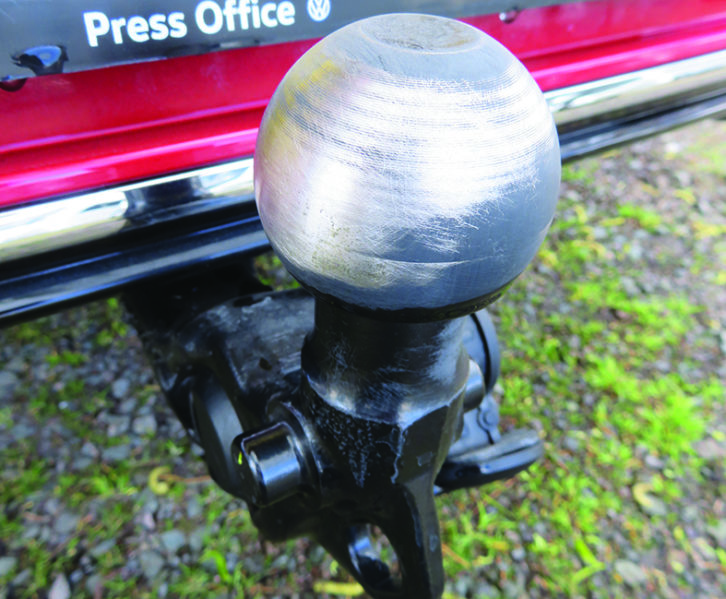
On the motorway, the Arteon impressed with its stability. There were some slight movements when we were passing HGVs or if caught by a sudden gust of wind, but nothing to get the palms sweating.
The VW proved to be just as happy when manoeuvring at low speeds on Broad Lane’s forecourt. The DSG auto was content to creep smoothly and slowly as required, and the rear-view camera gave a reassuringly clear view of the towball.
The towball itself drops and retracts at the push of a button, although it needs to be locked in place by hand. The electrics are mounted on the side, making it easy to twist the plug home without the car’s bumper getting in the way.
Solo driving
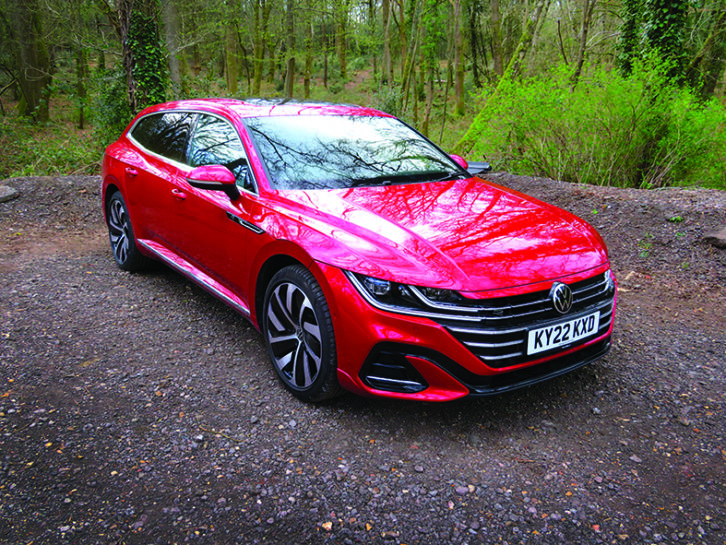
In everyday driving there’s more opportunity to make use of the Arteon Shooting Brake’s ability to travel on electric power alone.
Officially, it can travel up to 38 miles on electricity before a drop of fuel is needed. In practice, closer to 30 miles is going to be more likely. But that’s still enough for many journeys to be completed without any exhaust emissions.
There’s something very appealing about the smooth and quiet progress the Arteon makes running as an electric vehicle.
It’s nippy enough from a standing start, and you do find yourself trying to use electricity alone for as long as possible.
When the engine is needed, it’s mostly quiet and refined, only starting to sound strained if revved hard. Without the weight of the caravan to deal with, the powertrain seems to have plenty in reserve in normal driving. The Arteon hybrid is equally at home wafting through town as it is on the motorway.
The optional acoustic pack has sound-insulating laminated side glass, and light-absorbing glass in the rear windows and rear windscreen, as well as extra sound-deadening. No doubt this contributes to the hushed cabin at speed, and for £315 it’s not expensive.
Turn off the motorway onto country roads and the Arteon is satisfying to drive. The steering is accurate and well weighted (switching to ‘sport’ adds more heft), and the suspension is taut but comfortable. You are conscious of the car’s weight if you try to change direction in a hurry, but drive smoothly and the VW responds in kind.
Space and practicality
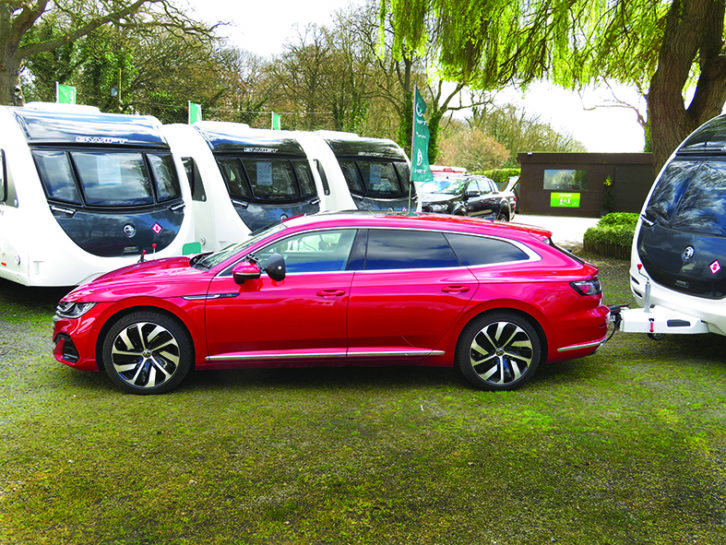
The Shooting Brake is highly practical for a car that places an emphasis on form as well as function. It’s just a shame the plug-in hybrid isn’t quite as useful as the rest of the range.
The Hybrid’s boot space is compromised, with a capacity of 455 litres rather than 590. That means the Shooting Brake has a lot less luggage space than a Volvo V60 hybrid (529 litres). There are other issues applying to all Arteon Sport Brakes, not just the hybrid. There’s a load lip, so you can’t simply slide heavy items into the boot. And although the rear seats split and fold, there are no release levers either side of the tailgate – you need to use the catches on top of the seat backs.
Otherwise, there’s little to complain about. Rear legroom is generous, with plenty of space for one six-footer to sit behind another. There’s enough headroom, too, even with the sunroof on R-Line spec cars.
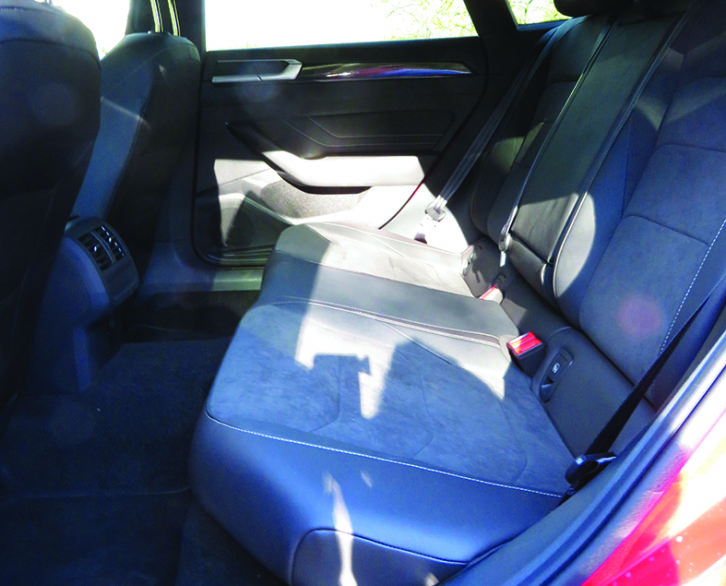
The touch-sensitive pads for changing the air-con are a step back – they are difficult and distracting to use on the move. Otherwise, the controls are straightforward enough.
We can’t help thinking the striking exterior deserves more imagination in the cabin. You could be behind the wheel of a Passat, and given the Arteon’s price tag, it would be nice if the finish and design had a bit more sparkle. Overall, though, the Shooting Brake is a very roomy, practical vehicle, compromised by its hybrid powertrain.
Buying and owning
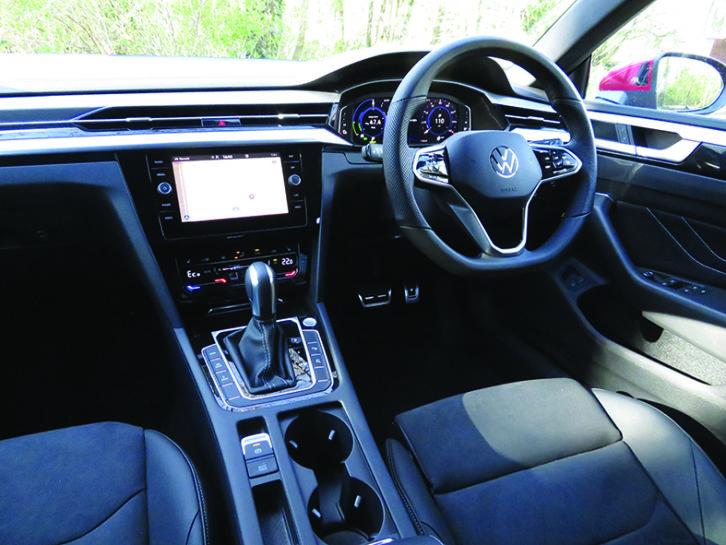
Prices for the hybrid Arteon Shooting Brake start at £44,125 for the Elegance model, rising to £45,055 for the R-Line.
Non-hybrid petrol models start at under £40,000 and the diesels are priced from £41, 670.
For company car drivers, favourable benefit-in-kind tax rates make the plug-in hybrid the model to choose. Business and private drivers will save on fuel bills, provided they recharge the car regularly and don’t have lengthy drives every day.
A good turbodiesel is more economical than a plug-in hybrid on a long trip, but we were impressed to see 47mpg on a solo motorway drive with the battery largely depleted.
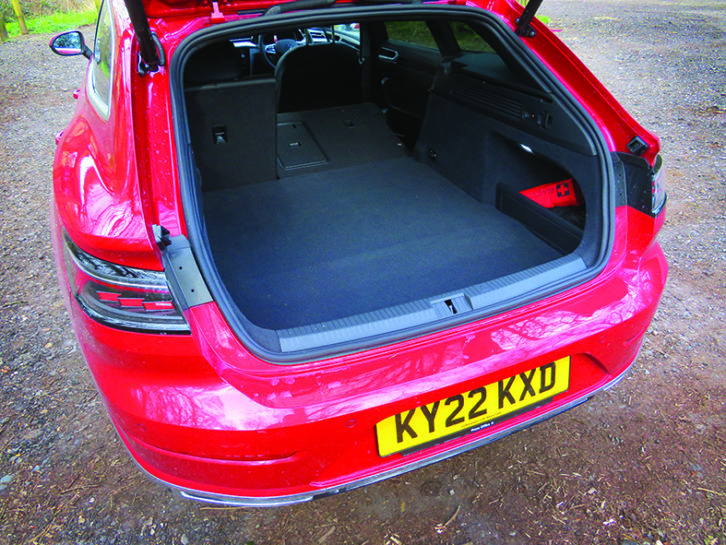
R-Line spec is well equipped, offering three-zone climate control, leather upholstery, heated front seats, eight-inch colour touchscreen, Apple CarPlay and Android Auto. Safety kit is comprehensive, contributing to a five-star score from Euro NCAP.
After three years and 36,000 miles, the Arteon hybrid should hold on to a respectable 46% of the original asking price.
How much will it cost on finance?
We found a real for the Arteon Shooting Brake that would cost £582.84 per month over three years from UK Carline Limited. An initial payment of £5245.56 (equivalent to nine months of rentals) is needed. Mileage would be capped at 10,000 per year, after which, further charges would apply. Maintenance could be included for £26.62 per month.
Verdict
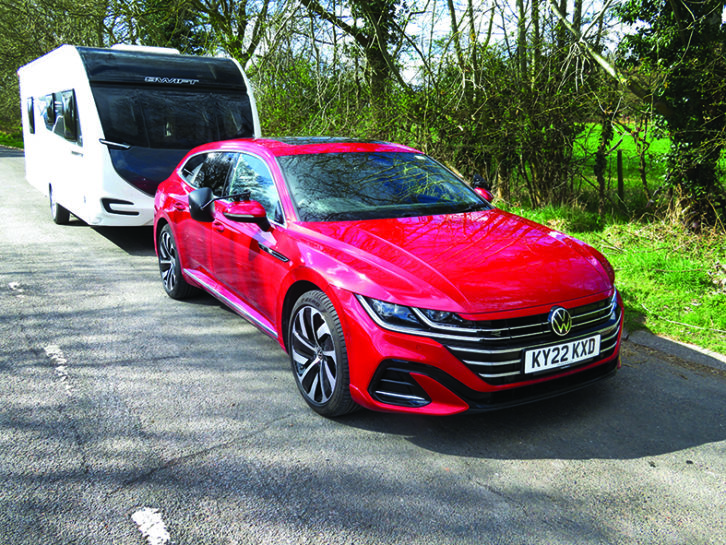
The Arteon Shooting Brake is a very capable vehicle, and for company drivers, the hybrid’s low tax bills make it the clear pick of the range. However, there are a few provisos for caravanners that stand between the VW and a five-star score.
Boot space is one. Although hugely roomy for people, squeezing in the batteries has stolen 135 litres from the Volkswagen’s luggage capacity. That’s a big chunk to lose, especially when Volvo has succeeded in electrifying the V60 estate without losing any room for bags.
We also think it’s a shame you can’t buy the Arteon hybrid with four-wheel drive, unlike some of the car’s key rivals. Then there’s the nagging feeling that the Passat GTE is a more practical version of largely the same car, only for less money. Such analysis ignores the appeal of the Arteon’s looks, which may be subjective, but is surely an important reason for choosing the Shooting Brake over more practical alternatives.
This also ignores the way the Shooting Brake drives. It’s a very fine tow car, extremely stable and happy to pull a sensibly matched caravan.
In solo driving, there’s a healthy turn of speed, but it’s when you’re driving in near silence around town, or covering long distances in great comfort, that you really appreciate the depth of the VW’s abilities.
We know that the Passat GTE is objectively the better car. Even so, we would be very tempted to pack carefully and choose the Arteon Shooting Brake instead.
If you’d like some more towing vehicle inspiration, be sure to take a look at our guide to the best tow cars.
If you liked this… READ THESE:
Review: VW Passat GTE Advance Estate
If you’ve enjoyed reading this article, why not get the latest news, reviews and features delivered direct to your door or inbox every month. Take advantage of our brilliant Practical Caravan magazine SUBSCRIBERS’ OFFER and SIGN UP TO OUR NEWSLETTER for regular weekly updates on all things caravan related.
It's nippy enough from a standing start, and you do find yourself trying to use electricity alone for as long as possible
Technical Specifications
| Engine Size | 1395 cc |
| Kerbweight | 1814 kg |
| 85% KW | 1542 kg |
| Towball Limit | 90 kg |
| Maximum Towing Limit | 1600 kg |
| Power | 218 bhp |
| Torque | 295 lb ft |
| Offical MPG | 201 mpg |
| Towing MPG | 28.3 mpg |
| CO₂ | 31 g/km |
